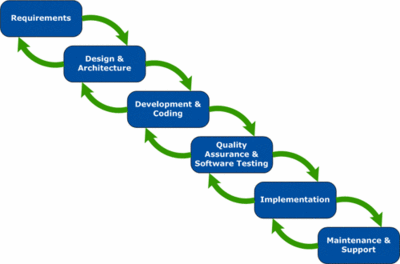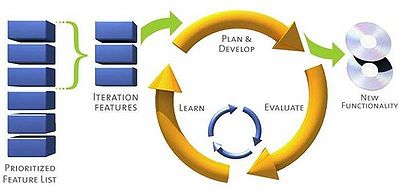Comparison of Schedule Managing Methods
| Line 13: | Line 13: | ||
When it comes to schedule managing methods in construction there are two overall ways the project life cycle is manged. These are sequential life cycle and adaptive life cycle. | When it comes to schedule managing methods in construction there are two overall ways the project life cycle is manged. These are sequential life cycle and adaptive life cycle. | ||
| − | [[File:Sequential_life_cycle.gif| | + | [[File:Sequential_life_cycle.gif|400px|thumb|right|Figure 1: Sequential life cycle <ref name=life_cyc>Simplilearn. (2013). ''Project Management Life Cycles - Evolution over the years''. Retrieved June 12, 2017, from https://www.simplilearn.com/project-management-life-cycles-evolution-article.</ref>]] |
The sequential life cycle is the most traditional way of managing construction projects whereas the adaptive methods has not been used as much. | The sequential life cycle is the most traditional way of managing construction projects whereas the adaptive methods has not been used as much. | ||
The main idea of the sequential life cycle is that the entire project is planned early on in the project. The plan consists of different phases which have specified ending criteria which have to be met before the successor phase can begin. This also means that the entire project has to well know. Since the entire project is planned in the early stages of the project, this way of planning is vulnerable to unforeseen changes which could have huge effects on the upcoming phases. There are several ways of conducting a sequential life cycle such as the critical path method or the critical chain method. | The main idea of the sequential life cycle is that the entire project is planned early on in the project. The plan consists of different phases which have specified ending criteria which have to be met before the successor phase can begin. This also means that the entire project has to well know. Since the entire project is planned in the early stages of the project, this way of planning is vulnerable to unforeseen changes which could have huge effects on the upcoming phases. There are several ways of conducting a sequential life cycle such as the critical path method or the critical chain method. | ||
| − | The adaptive life cycle | + | The adaptive life cycle, as the name states, is a managing method that adapts to the projects as it progresses. The way this is typically done in construction is that the |
| − | [[File:Adaptive_life_cycle.jpeg| | + | [[File:Adaptive_life_cycle.jpeg|400px|thumb|right|Figure 2: Adaptive life cycle <ref name=life_cyc>Simplilearn. (2013). ''Project Management Life Cycles - Evolution over the years''. Retrieved June 12, 2017, from https://www.simplilearn.com/project-management-life-cycles-evolution-article.</ref>]] |
<!--[[File:Placeholder.jpg|300px|thumb|center|Figure 1: Example figure text]]--> | <!--[[File:Placeholder.jpg|300px|thumb|center|Figure 1: Example figure text]]--> | ||
Revision as of 16:02, 12 June 2017
Projects involve many different tasks that must be done to complete the project. Many of these tasks will in construction projects logically depend on each other. For example, it is necessary to build supporting walls or columns before the roof can be installed. There are several methods to keep track of these dependencies. In this article three similar methods will be explained and their differences will be compared together with their pros and cons. The three methods compared in this article are the critical path method (CPM), the critical chain method (CCM) and critical space analysis (CSA).
The critical path method works by dividing a project into smaller tasks. The duration for these tasks are estimated by either comparing similar tasks in earlier projects or by asking those who are in charge of the specific task. These duration estimates naturally have some amount of uncertainty; however, this uncertainty is not considered in the critical path method. This uncertainty either must be accepted or considered externally with the use of probabilistic methods. When the tasks are defined and the durations are specified, the tasks can be put into a schedule. The schedule is made so that tasks that needs other tasks to finish beforehand are put in a path. The longest duration of the paths then defines the critical path and thereby the shortest execution time of the project.
The critical path method does not take resources into account when calculating the shortest execution time. For this, other methods can be used such as the critical chain method. This method takes labour and equipment into account. The critical chain in the project is calculated similarly to the critical path method however this method calculated the longest resource-constrained path.
In small construction sites with limited space the workers may not be able to work effectively simultaneously. The critical space analysis addresses this issue by using the available space as a resource similarly to the critical chain method. The fastest execution time of the project then depends on reduced effectiveness of the work. [1]
Contents |
Description of different schedule managing methods
When it comes to schedule managing methods in construction there are two overall ways the project life cycle is manged. These are sequential life cycle and adaptive life cycle.

The sequential life cycle is the most traditional way of managing construction projects whereas the adaptive methods has not been used as much. The main idea of the sequential life cycle is that the entire project is planned early on in the project. The plan consists of different phases which have specified ending criteria which have to be met before the successor phase can begin. This also means that the entire project has to well know. Since the entire project is planned in the early stages of the project, this way of planning is vulnerable to unforeseen changes which could have huge effects on the upcoming phases. There are several ways of conducting a sequential life cycle such as the critical path method or the critical chain method.
The adaptive life cycle, as the name states, is a managing method that adapts to the projects as it progresses. The way this is typically done in construction is that the

Application
Limitations
Annotated Bibliography
Winch, Graham (2010), "Managing Construction Projects. An Information Processing Approach" Second Edition, Wiley-Blackwell, United Kingdom. ISBN 978-1-4051-8457-1.[1]
Description.
References
- ↑ 1.0 1.1 Winch, Graham (2010), "Managing Construction Projects. An Information Processing Approach" Second Edition, Wiley-Blackwell, United Kingdom. ISBN 978-1-4051-8457-1.
- ↑ 2.0 2.1 Simplilearn. (2013). Project Management Life Cycles - Evolution over the years. Retrieved June 12, 2017, from https://www.simplilearn.com/project-management-life-cycles-evolution-article.